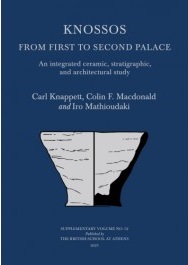The British School at Athens Supplementary Volumes continue the BSA’s commitment to publish the results of field research carried out under its aegis. These volumes are available on the Pen and Sword Books website.
Supplementary Volumes
New publication, July 2024
Phylakopi, Melos, 1896–99: The Finds in the National Archaeological Museum, Athens. By R. L. N. Barber. BSA Suppl. Vol. 53 (2 volumes). London 2024. ISBN 978-0-904887-75-4
The site of Phylakopi on Melos has a special place in the prehistory of the Aegean world as the first (1896–99) stratified settlement to be excavated in the Cyclades. The finds, transferred to the National Archaeological Museum in Athens at the close of the excavations, are here described in detail and extensively illustrated. New commentaries, based on recent developments in research and scientific analysis, throw fresh light on every aspect of the finds from the site and their implications for our understanding of the Bronze Age Aegean.
- 1More information
The site of Phylakopi on Melos occupies a special place in the prehistory of the Aegean Bronze Age. The first work there by the British School at Athens in 1896–99 (there were two further campaigns, in 1911 and 1974–77) was memorably described by Carl Blegen as ‘the first really serious effort to understand stratification, the first really good excavation in Greece’. The Field Director, Duncan Mackenzie, kept detailed day-to-day records of the work, later applying methods developed on Melos to the excavation of Knossos. The circumstances surrounding the initial excavation permit for Phylakopi and the role of Christos Tsountas, who later organised the Cycladic displays in the National Archaeological Museum in Athens, are here examined in an opening Chapter.
Following the 1896–99 excavations, the retained finds were sent to the National Archaeological Museum, where they remain today, thus providing the basis for the studies published here. Although the first publication (1904) of the finds was of exceptional quality for its time — indeed Campbell Edgar’s exemplary account of the pottery provided the foundation of a sequence for the Cyclades — it lacked detailed catalogue descriptions and scale drawings, essential for archaeological analysis and comparison. This double Volume fills such gaps and re-examines the significance of the finds, taking advantage of recent developments in research and scientific techniques.
Petrographic, chemical and pXRF analyses clarify the nature and sources of materials used, as well as technological aspects, helping to shed light on relationships with other Cycladic islands, Crete, and the Greek mainland. The coarse and undecorated pottery is fully described for the first time, providing a template for future work. Finds of post-prehistoric date, housed with the Phylakopi material but certainly not from the site, are presented with explanations as to their probable origin in other (unpublished) British School excavations on Melos. Chapters on bone/ivory, metals, and stone all contribute new insights into the discoveries at Phylakopi and their implications for our understanding of the Bronze Age Cyclades and beyond, while the Chapter on weaving undoubtedly has broader relevance to sites elsewhere in the Aegean. A major new study of the physically meagre fresco fragments, illustrated with fine watercolour visualisations, reconstructs the decoration of the Pillar Crypt complex and places it in the context of contemporary Aegean wall painting. Indeed the wealth of illustrations in this publication — line drawings, half-tone and colour plates — will now allow informed comparisons between Phylakopi and other sites of the Bronze Age Aegean.


